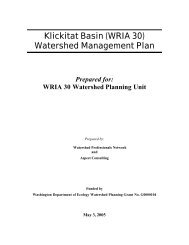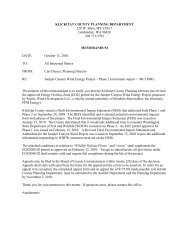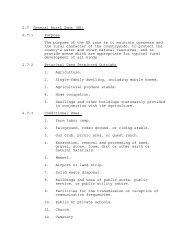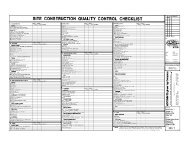WRIA 31 Instream Habitat Assessment
WRIA 31 Instream Habitat Assessment - Klickitat County Home
WRIA 31 Instream Habitat Assessment - Klickitat County Home
Create successful ePaper yourself
Turn your PDF publications into a flip-book with our unique Google optimized e-Paper software.
The Rock Creek steelhead population is part of the Middle Columbia Steelhead DistinctPopulation Segment, which is listed as threatened under the Federal Endangered SpeciesAct. Prior to this study, steelhead use of other subbasins within the <strong>WRIA</strong> was unknown;however, use of some of the other subbasins by steelhead was suspected. In August2005, NOAA Fisheries designated portions of Rock Creek, Chapman Creek, WoodGulch, Pine Creek, Alder Creek, and Glade Creek as critical habitat (NOAA 2005).2.1.1 Physical Setting<strong>WRIA</strong> <strong>31</strong> drains south from the Horse Heaven Hills into the Columbia River. Elevationsrange from nearly 4,800 feet in the northern part of the Rock Creek subbasin to 266 feetat the Columbia River, and generally decrease from west to east and from north to south.The entire <strong>WRIA</strong> is underlain by the Miocene Columbia River Basalt, including theGrande Ronde, Wanapum, and Saddle Mountain Basalt members (WDNR 2000). TheWanapum Basalt is the dominant geologic formation in Rock Creek, with the youngerSaddle Mountain Basalt dominating the Wood Gulch and Pine Creek subbasins. Thevolcanic bedrock forms the steep canyon walls of many of the larger streams as they havecut down into the basalt, and provides gravel- and cobble-sized particles to these streamsas well as forming bedrock chutes and falls in a few locations.Quaternary flood deposits and loess overlie the basalt in the Eastern part of the <strong>WRIA</strong>,and cover most of the Glade Creek subbasin. The flood deposits were left behind duringPleistocene outburst floods from glacial Lake Missoula and include gravel along theColumbia River grading to sand and silt deposits as far as 17 miles inland from the riverin the Glade Creek subbasin. Quaternary loess deposits, wind-blown silt and fine sand,cover the northern part of Glade Creek. The fine-grained flood deposits and loess areeasily eroded by running water; the major channels in the Glade Creek subbasin haveeroded down to the basalt bedrock. Chapman Creek is also dominated by the Quaternaryflood deposits. Loess overlays most of the subbasin.Shrub land and grassland dominate <strong>WRIA</strong> <strong>31</strong> (Aspect and WPN 2004). Rock Creek isthe only subbasin in the <strong>WRIA</strong> with a substantial amount of timber land (25.8%), whichis located in the headwaters of the subbasin (Aspect and WPN 2004). Less than 10percent of the land in Rock Creek basin is cultivated. Larger portions of the subbasinlands are cultivated in the smaller eastern basins (Glade and Alder Creek basins) (IRZ2004). There is little urban/residential development in <strong>WRIA</strong> <strong>31</strong>, except near Kennewickat the eastern end of the <strong>WRIA</strong> (Aspect and WPN 2004).Two recent forest/range fires have affected the study area. The Cleveland fire burned18,500 acres in the headwaters of Rock Creek in 1998 and the Wood Gulch fire burned11,640 acres in that basin in 2007(www.wsp.wa.gov/fire/docs/mobilization/mobe_history_for_2008.pdf).Precipitation decreases from west to east across the <strong>WRIA</strong> and also decreases from northto south (Aspect and WPN 2004). Specifically, mean annual precipitation ranges from<strong>WRIA</strong> <strong>31</strong> <strong>Instream</strong> <strong>Habitat</strong> <strong>Assessment</strong> 3 Watershed Professionals Network









